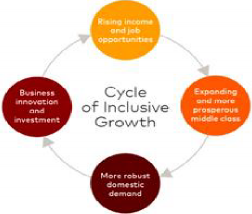According to OECD ‘Inclusive growth is an economic growth that “creates opportunity for all segments of the population and distributes the dividends of increased prosperity, both in monetary and non-monetary terms, fairly across society”.
The UNDP perspective on inclusive growth is based both on outcome and process. It implies that everyone should be able to participate in the growth process and the benefits should be shared equally. The UN Sustainable Development Goals (SDGs) do not directly mention inclusive growth, but some targets, if achieved, will help move towards inclusive growth. These include:
♤ Goal 1: Removal of poverty by half by 2030
♤ Goal 2: ending hunger by 2030
♤ Goal 3: reducing maternal mortality rates and infant mortality rates to fixed targets by 2030
♤ Goal 4: completely free, equitable and quality primary and secondary education to all girls and boys by 2030
♤ Goal 4: ensuring equal access for all women and men to affordable and quality technical, vocational and tertiary education, including university by 2030
♤ Goal 8: Sustained per capita economic growth and reduction of youth unemployment
♤ Goal 9: developing quality, reliable, sustainable and resilient infrastructure, promoting inclusive and sustainable industrialisation and, by 2030, significantly raise industry’s share of employment and gross domestic product (GDP).

